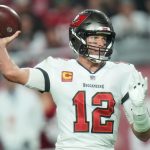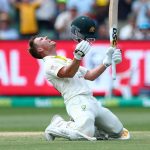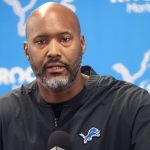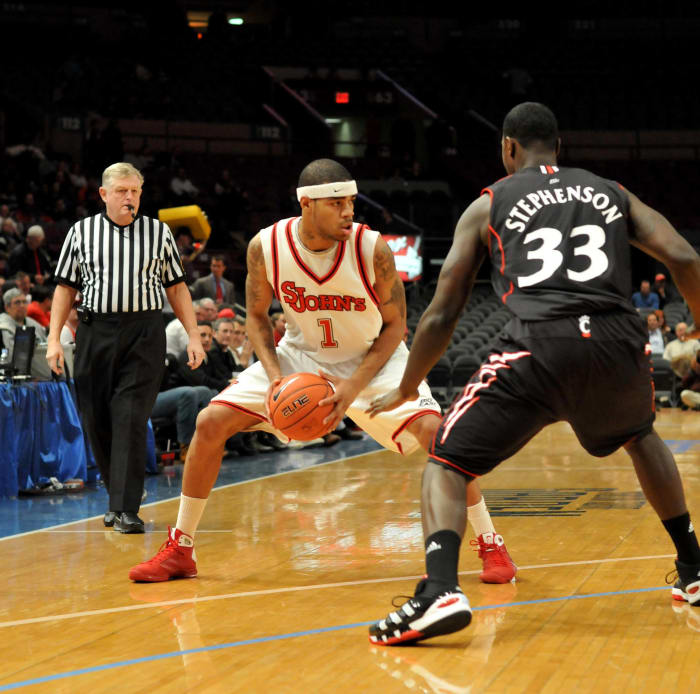Redrafting the 2011 NBA Draft
The 2011 NBA Draft class will go down as one of the greatest in NBA history. As many as five players will make the Hall of Fame. A number of other players made All-Star teams and/or major contributions to championship teams. Above all else, with one unfortunate exception (Isaiah Thomas), most of this class got PAID.
Ironically, this draft class also had some spectacular busts in the top-10 and some impactful late-round sleepers. Here’s how this fascinating draft class should have panned out.
Kyrie Irving
As great as this draft class is, the first pick is an absolute no-brainer: Kawhi Leonard. The two-time Finals MVP is the obvious pick here because he’s the one true superstar whose presence alone guarantees that your team will be a contender as he has the best winning percentage in NBA history for players who have appeared in at least 150 games. This re-draft presents the Cavs with a fascinating “what if” as well: What if they’d drafted Kawhi Leonard and Kyrie Irving with pick nos. 1 and 4 instead of Kyrie and Tristan Thompson?
Derrick Williams
Though a case can be made here for Jimmy Butler, Klay Thompson is the better choice for the T’Wolves at no. 2. Back in 2011, Thompson was a perfect player for the coming three-point revolution that was about to take the NBA by storm (career 41.9 percent three-point shooter). He’s also been an excellent defender, especially against some of the league’s most elite point guards. Thompson and Kevin Love were almost traded for one another in 2014 – they would have made for great teammates in Minnesota.
Enes Kanter
Fresh off an incredible playoff run that saw him submit two of the finest Finals performances in recent memory, Butler is an easy choice over Kyrie Irving for the Jazz here at no. 3. Why? Because, unlike Mr. Irving , Butler drives winning. He may rub people the wrong way at times with his crazy work ethic and “win at all costs” mentality, but the proof is in the pudding for the five-time All-Star. Imagine where the Jazz would be now had they selected Butler the year after they drafted Gordon Hayward.
LeBron James would have returned to Cleveland with a young roster ready to dominate the NBA for years to come. Hell, the Cavs might still be winning titles today if they’d selected Leonard and Irving in 2011.
Jonas Valanciunas
Possibly the fifth Hall of Fame member of the draft class of 2011, Kemba Walker is the clearcut choice for the Raptors at no. 5. In nine NBA seasons, the UConn star has averaged 19.9 ppg. and 5.4 apg. on 42-36-84 shooting. Unfortunately for Kemba, eight of those seasons were spent with the miserable Bobcats/Hornets franchise. Here, he gets to go to a well-run organization in Toronto and presumably becomes what Kyle Lowry is presently to the Raptors.
Jan Vesely
Although IT, Vucevic, Tobias Harris are all on the board, Tristan Thompson was the guy for the Wizards to pair with then-second year blur of a point guard, John Wall. Thompson is everything the Wizards thought they were getting with Vesely, and then some. As he proved in the 2016 NBA Finals, Thompson was athletic enough to help swing the Finals with his energy on the boards and ability to switch out onto the perimeter. He was never a star (career averages of 9.4 ppg., 8.7 rpg.), but he was a star in his role. At pick no. 6 of any draft, that’s good value.
Bismack Biyombo
Though the Kings traded the rights of Biyombo to the Bobcats as part of a three-team deal that landed them Jimmer Fredette (whoops!), we’re going to presume that they keep this pick for re-drafting purposes. Though it’d be tempting to select Isaiah Thomas – the future All-NBA guard the Kings selected with the 60th pick back in 2011 – Sacramento goes with the ever-consistent big man, Nikola Vucevic. Over his past six seasons, the USC product has averaged 18.2 ppg. and 10.5 rpg. Vucevic’s availability edges him over IT, whose career has been hampered by injuries.
Brandon Knight
The IT-Detroit Redux!! One of the ultimate chip on his shoulder players, Isaiah Thomas jumps from being Mr. Irrelevant (pick no. 60) to the top-10. Had he not suffered a career-altering hip injury in the 2016-17 season, he may have gone even higher in the re-draft as he was good enough to finish fifth in the 2016-17 MVP vote (28.9 ppg. and 5.9 apg. on 46-38-91 shooting).
Bojan Bogdanovic sure would. Bogdanovic would probably have gone in the top-10 if it weren’t for the fact that he spent the next three seasons after being drafted in Turkey before coming to the NBA in 2014-15. His underrated offensive ability (20.2 ppg. last season) and deadeye three-point shooting ability (39.4 percent for his career) would make him worth the wait.
Alec Burks
Just like in the 2011 NBA Draft, the Morris Twins go back-to-back in the re-draft, only this time, Marcus Morris goes first as he’s had a slightly better statistical career. After a slower start, Morris has averaged a very solid 14.4 ppg. and 5.2 rpg. with 42-37-80 shooting splits since 2016. He’s the ideal bigger three-and-D player who can slide between small forwards and power forwards on defense. This re-draft bodes much better for Utah than 2011 did – they walk away with Jimmy Butler and Marcus Morris instead of Enes Kanter and Alec Burks.
Markieff Morris
Keef Morris winds up in the same spot that he was drafted in 2011, landing in Phoenix with the 13th overall pick. While things ended on a sour note with the Suns, Markieff enjoyed arguably the best season of his career there in 2014-15, when he averaged 15.3 ppg. and 6.2 rpg. In this re-draft alternate reality, perhaps the Suns never acquire Marcus Morris from the Rockets, and thus, never have an opportunity to screw over the Morris twins by negotiating a combo contract, only to trade both shortly thereafter.
George Hill. With Kawhi off the board, let’s assume the Spurs aren’t willing to make that deal again, so instead, the Pacers will select the best point guard available, Brandon Knight. For those that just did a double-take, remember that Knight was considered a decent prospect the first five years of his career before injuries got in the way (he averaged 15.9 ppg. and 4.6 apg. from 2012 through 2016). Much like Hill, Knight could have provided the soon-to-be contending Pacers some solid offensive play and steady production for a number of years so long as he stayed healthy.
Billy Donovan’s infamous “Can’t play Kanter” remark to himself on the sidelines in 2017?
Iman Shumpert
Kenneth Faried, Markieff Morris and Chandler Parsons have all had similar career arcs – they all started out looking like high-level role players, or even future All-Stars, and all have largely disappointed in recent years. Faried’s drop-off from age 27 to 30 has been pretty staggering, though it mostly relates to his poor defense. Through his first five seasons, Faried averaged 12.3 ppg. and 8.7 rpg.; the next three seasons, he averaged 8.9 ppg. and 6.7 rpg. Last season, he played in China. At least he’d give the Knicks fans some thrills for a handful of years with his frenetic, hustle plays.
Chris Singleton
Instead of going zero for two with their 2011 draft, the Wizards get a sure thing at pick no. 6 with Tristan Thompson, and take a home run swing at pick no. 18 with Derrick Williams, a top prospect whose career may have turned out a lot differently had he not gone to such a poorly run organization in Minnesota.
Donatas Motiejunas
Two things keep this sweet-shooting stretch-four from going higher in the re-draft: for one, he didn’t make his way to the NBA until 2014 (recall that he was one of the Bulls’ best assets between 2011 and 2014); and second, he went back to Europe for big money after only five NBA seasons. Even though they’d only get Mirotic for a few seasons, five years of 12.3 ppg. and 5.9 rpg. on 42-36-81 shooting is about the best you can do if you’re Minnesota at pick no. 20.
Nolan Smith
Shumpert’s career numbers aren’t all that impressive (7.2 ppg., 3.3 rpg. and 1.8 apg. with 39-34-76 shooting splits), but his value was more on the defensive side of the ball. A good athlete, standing at 6-foot-5 and weighing 215 pounds, Shumpert was able guard small forwards, shooting guards, and point guards, including guys like Steph Curry in high-pressure playoff games. That skill alone justifies this pick at no. 21 for the Blazers, who would ironically go on to face Steph Curry countless times in the playoffs between 2011 and today.
James Harden during the mid-to-late 2010s.
Kevin Durant and Russell Westbrook-led Thunder. While we’re rewriting Thunder history, let’s hope they don’t bother trading James Harden while they’re at it.
Kendrick Perkins once provided for them before they traded him in the 2010-11 season.
Jordan Hamilton
Even in a draft as deep at the 2011 draft, it gets to be slim pickings after about 20-25 picks. In a handful of his best seasons, like 2016-17 where he averaged 9.3 ppg. and 3.3 apg., Joseph was an above-average backup point guard. That will have to do at no. 26 for the Mavericks, who were fresh off of their shocking championship victory over the Heat.
JaJuan Johnson
Moore gets the call here at no. 27, replacing his former college teammate from Purdue, JaJuan Johnson. Though he’s never had a super memorable moment in the league, Moore is a backup guard who can come in and get you some buckets – career average of 8.1 ppg. on 39 percent three-point shooting. He’ll land on the Nets a year before their infamous Paul Pierce and KG trade.
Miami Heat, we’re not doing any trades in the re-draft, so Cole goes in the same position, but ends up with the Heat’s biggest rival in 2011, the Chicago Bulls. Cole would have made for a nice backup point guard to Derrick Rose, which could have been very helpful as we all know how coach Tom Thibodeau drove Rose into the ground, eventually leading to him tearing his ACL in the 2012.
Cory Joseph
Wanamaker has had one of the more unique voyages to the NBA – going undrafted out of Pitt, playing overseas through 2017-18, and becoming a 29-year-old rookie in 2018-19 for the Celtics. In this re-draft reality, we’re going to assume that Wanamaker’s NBA skills get developed at a more expedited rate by Gregg Popovich and the Spurs, so we’d probably see the current version of Wanamaker (6.5 ppg., 2.5 apg., 2.0 rpg. with 45-38-93 shooting splits this past season) a lot sooner.
30 of 30
30. Chicago Bulls – DJ Kennedy (Undrafted)
Bennett Cohen/Icon Sportswire
Original Pick: Jimmy Butler
Who? This pick is admittedly a bit of a stretch, but it’s pick no. 30 – do you think the Bulls really want to run-back MarShon Brooks’ career here? For those that watch The Basketball Tournament every summer, Kennedy is its most decorated player, winning four straight championships with Overseas Elite and taking home the tournament MVP honors in 2015. At 6-foot-6, Kennedy possessed nice size and athleticism for the positionless direction the NBA was going after his four years at St. Johns. Sadly, he missed out on a chance at being drafted after he tore his ACL shortly before March Madness in 2011. He gets his NBA reprieve in the re-draft.





